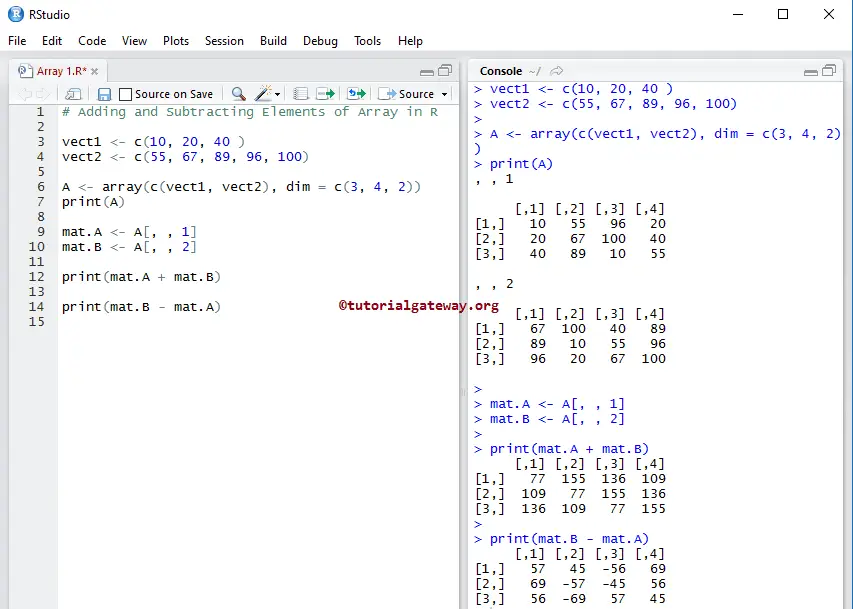An Array in R Programming is simply called a multi-dimensional Data structure. In Array, data is stored in matrices, rows, and columns, and we can access the matrix element using the matrix level, row index, and column index.
In this article, we show how to Create an array in R, How to Access the Elements, and Performing Arithmetic Operations on them with an example.
Array in R Programming Syntax
The syntax of the Array is
Array_Name <- array(data, dim = (row_Size, column_Size, matrices, dimnames)
If you observe the above R array code snippet, the data is a Vector and
- Matrices: It will decide the number of Matrices an array can accept. The array is always a Multi-Dimensional, which means more than 1 matrix with rows and columns.
- Row_Size: Please specify the number of Row elements it can store. For example, if Row_Size =5, then each matrix in an array will have 5 rows.
- Column_Size: Number of Column elements an array can store. For example, Column_Size = 6, then each matrix in an array will have 6 Columns.
- dimnames: It is used to change the default Row, Column, and Matrix names to more meaningful names.
Create an Array in R
In this example, we will create an Array. The following code snippet will show you the most traditional way to create it in the R Programming language.
# Create A <- array(1: 24, dim = c(3, 4, 2)) print(A) vect1 <- c(10, 20, 30, 40) vect2 <- c(50, 60, 70, 80, 90, 100) B <- array(c(vect1, vect2), dim = c(3, 3, 2)) print(B)
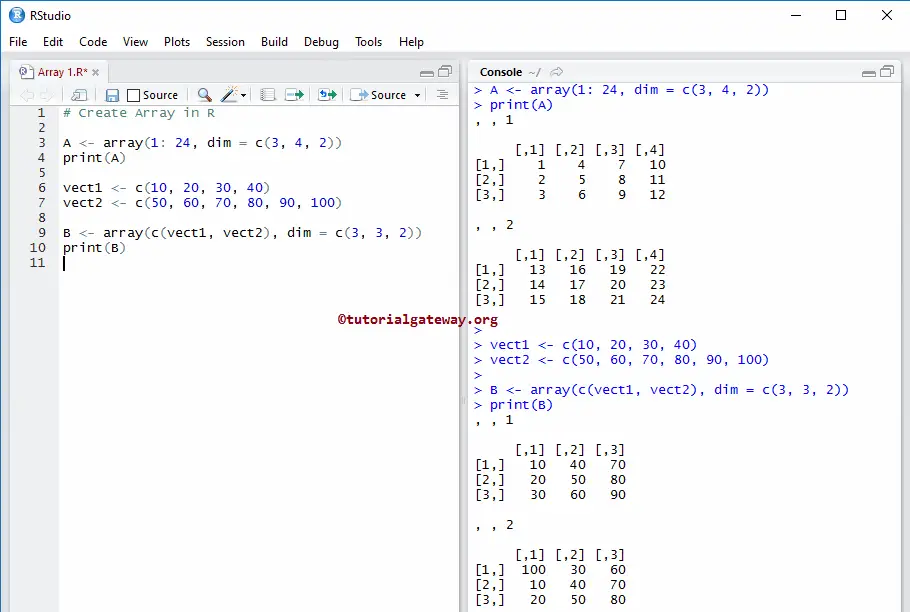
The below R statement will create an Array of elements from 1 to 24 arranged in two matrices, and each matrix contains three rows and four columns.
A <- array(1: 24, dim = c(3, 4, 2))
Next, we created two vectors.
vect1 <- c(10, 20, 30, 40) vect2 <- c(50, 60, 70, 80, 90, 100)
From the above screenshot, you can observe that we are using the c or concatenation function to combine those vectors to create an array of the elements arranged in two Matrices. Each matrix will contain three rows and three columns.
B <- array(c(vect1, vect2), dim = c(3, 3, 2))
Defining Row names and Column names for Array in R
In this example, we will show how to replace the default names of the Rows, Columns, and matrices or define new names for the Rows, Columns, and Matrices in Arrays. We can achieve the same using dimnames as: x <- matrix(1:12, dimnames = list(rowNames, columnNames, matrixNames) .
A <- array(1: 24, dim = c(3, 4, 2))
print(A)
# Defining Row names and Column names of Matrix in R
row.names <- c("Row1", "Row2", "Row3")
column.names <-c("Col1", "Col2", "Col3", "Col4")
matrix.names <-c("Matrixl1", "Matrix2")
B <- array(1: 24, dim = c(3, 4, 2), dimnames = list(row.names, column.names, matrix.names))Defining Row names and Column names
print(B)
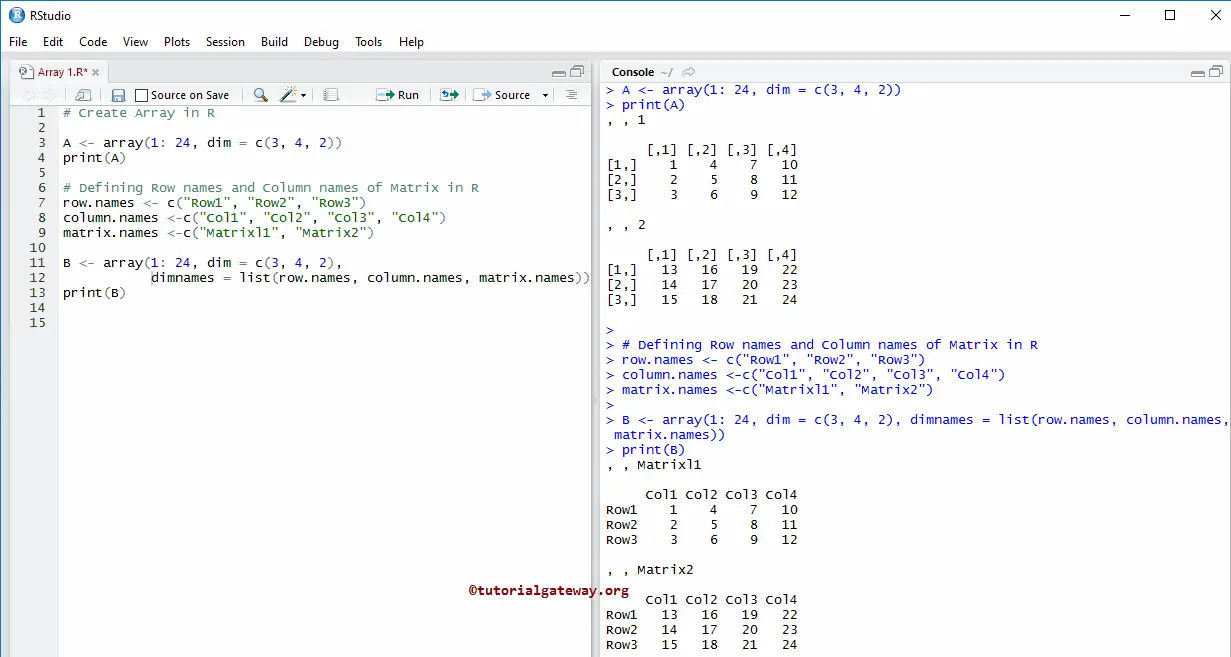
Accessing Array Elements
In R programming, we can use the index position to access the array elements. Using the index, we can access or alter/change each and every individual element present in it. Index value starts at 1 and ends at n, where n is the size of a matrix, row, or column.
The syntax behind this Array accessing is:
Array_Name[row_position, Column_Position, Matrix_Level].For example, we declared an array of two matrices of size 6 rows * 4 columns. To access or alter 1st value, use Array_name[1, 1, 1], to access or alter 2nd-row 3rd column value at 1st Matrix level, then use Array_name[2, 3, 1] and to access the 6th-row 4th column in 2nd matrix level then use Array_name[6, 4, 2]. Let’s see the example for better understanding:
# Accessing Elements A <- array(1: 24, dim = c(3, 4, 2)) print(A) # Access the element of 1st row and 2nd column in Matrix 1. print(A[1, 2, 1]) # Access the element of 3rd row and 4th column in in Matrix 2. print(A[3, 4, 2]) # Access only the 3rd row in First Matrix. print(A[3, , 1]) # Access only the 4th column in Second. print(A[, 4, 2]) # Access the Complete First. print(A[ , , 1]) # Access the Complete Second. print(A[ , , 1])
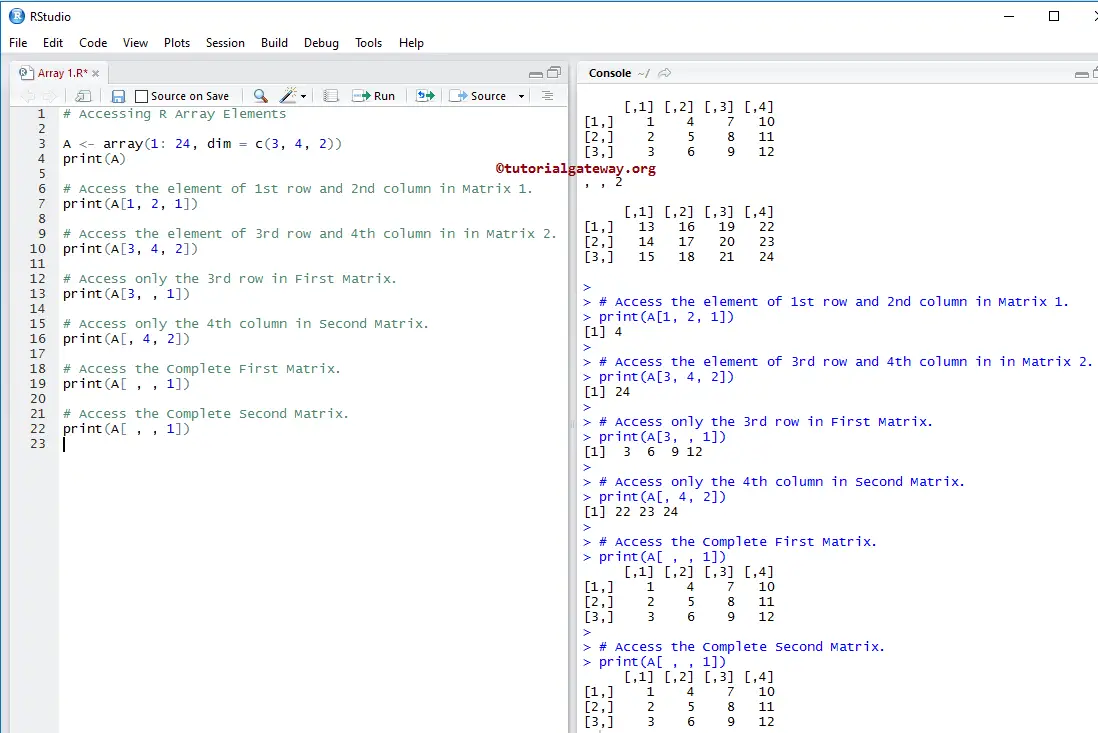
Access All elements of Array in R
In this example, we show you the process of accessing each and every element present in an Array.
# Accessing Elements
StudentArray <- array(10: 34, dim = c(3, 4, 2))
print(StudentArray)
print(paste("Element at StudentArray[1, 1, 1] = ", StudentArray[1, 1, 1]))
print(paste("Element at StudentArray[1, 2, 1] = ", StudentArray[1, 2, 1]))
print(paste("Element at StudentArray[1, 3, 1] = ", StudentArray[1, 3, 1]))
print(paste("Element at StudentArray[1, 4, 1] = ", StudentArray[1, 4, 1]))
print(paste("Element at StudentArray[2, 1, 1] = ", StudentArray[2, 1, 1]))
print(paste("Element at StudentArray[2, 2, 1] = ", StudentArray[2, 2, 1]))
print(paste("Element at StudentArray[2, 3, 1] = ", StudentArray[2, 3, 1]))
print(paste("Element at StudentArray[2, 4, 1] = ", StudentArray[2, 4, 1]))
print(paste("Element at StudentArray[1, 1, 2] = ", StudentArray[1, 1, 2]))
print(paste("Element at StudentArray[1, 2, 2] = ", StudentArray[1, 2, 2]))
print(paste("Element at StudentArray[1, 3, 2] = ", StudentArray[1, 3, 2]))
print(paste("Element at StudentArray[1, 4, 2] = ", StudentArray[1, 4, 2]))
print(paste("Element at StudentArray[2, 1, 2] = ", StudentArray[2, 1, 2]))
print(paste("Element at StudentArray[2, 2, 2] = ", StudentArray[2, 2, 2]))
print(paste("Element at StudentArray[2, 3, 2] = ", StudentArray[2, 3, 2]))
print(paste("Element at StudentArray[2, 4, 2] = ", StudentArray[2, 4, 2]))
# To Access Third Row and 1, 2, 3, 4 Columns inside Ist Matrix
print(paste("Element at StudentArray[3, 1, 1] = ", StudentArray[3, 1, 1]))
print(paste("Element at StudentArray[3, 2, 1] = ", StudentArray[3, 2, 1]))
print(paste("Element at StudentArray[3, 3, 1] = ", StudentArray[3, 3, 1]))
print(paste("Element at StudentArray[3, 4, 1] = ", StudentArray[3, 4, 1]))
# To Access Third Row and 1, 2, 3, 4 Columns inside 2nd Matrix
print(paste("Element at StudentArray[3, 1, 1] = ", StudentArray[3, 1, 2]))
print(paste("Element at StudentArray[3, 2, 1] = ", StudentArray[3, 2, 2]))
print(paste("Element at StudentArray[3, 3, 1] = ", StudentArray[3, 3, 2]))
print(paste("Element at StudentArray[3, 4, 1] = ", StudentArray[3, 4, 2]))
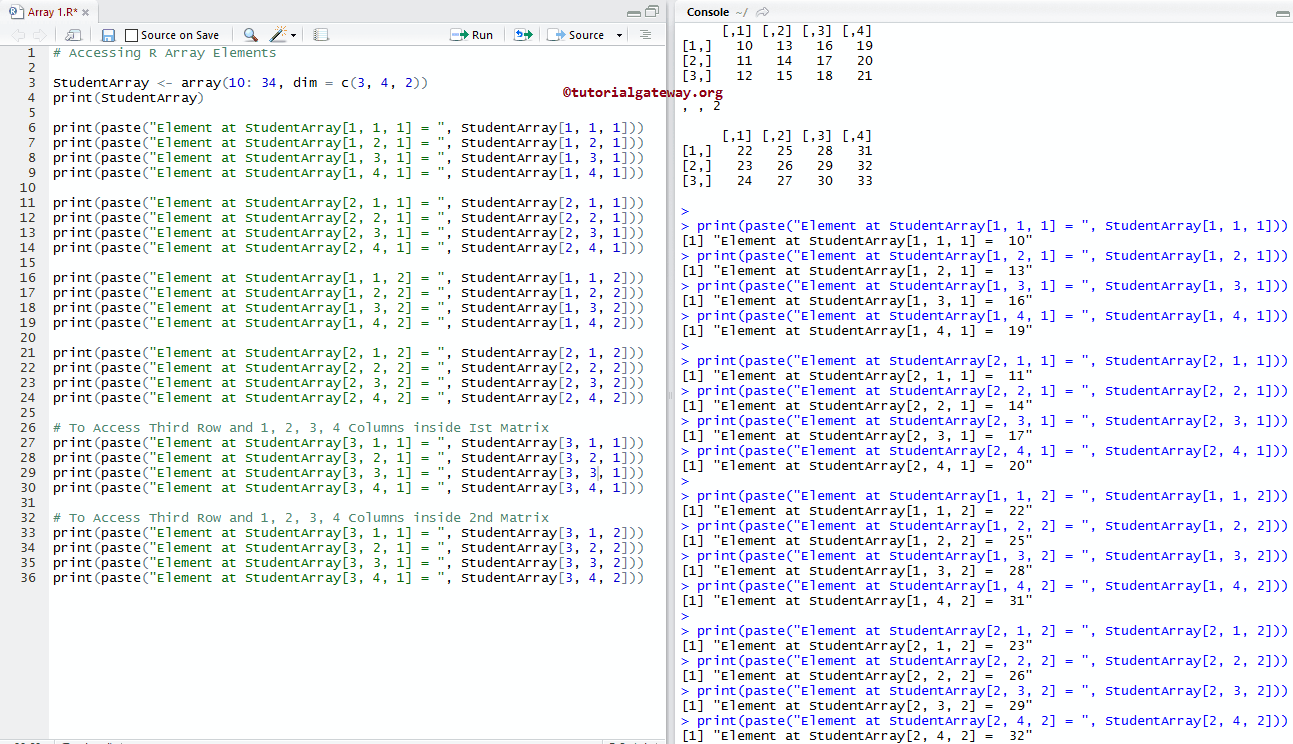
Accessing Subset of an Array Elements
In our previous example, we show you how to access a single element from the R Array. In this example, we will show how to access the subset of multiple items from the Array. To achieve the same, we use the R Vector.
TIP: Negative index position omits those values from an Array in R.
# Accessing Elements A <- array(1: 24, dim = c(3, 4, 2)) print(A) # Access the elements of 1st, 3rd row and 2nd, 4th column in Matrix 1. print(A[c(1, 2), c(3, 4), 1]) # Access All the element of 2nd and 3rd row in Matrix 2. print(A[c(2, 3), , 2]) # Access All the element of 1st and 4th Column in Matrix 1. print(A[ , c(1, 4), 1]) # Access All the element except 2nd row and 3rd Columm in Matrix 2. print(A[-2, -3, 2])
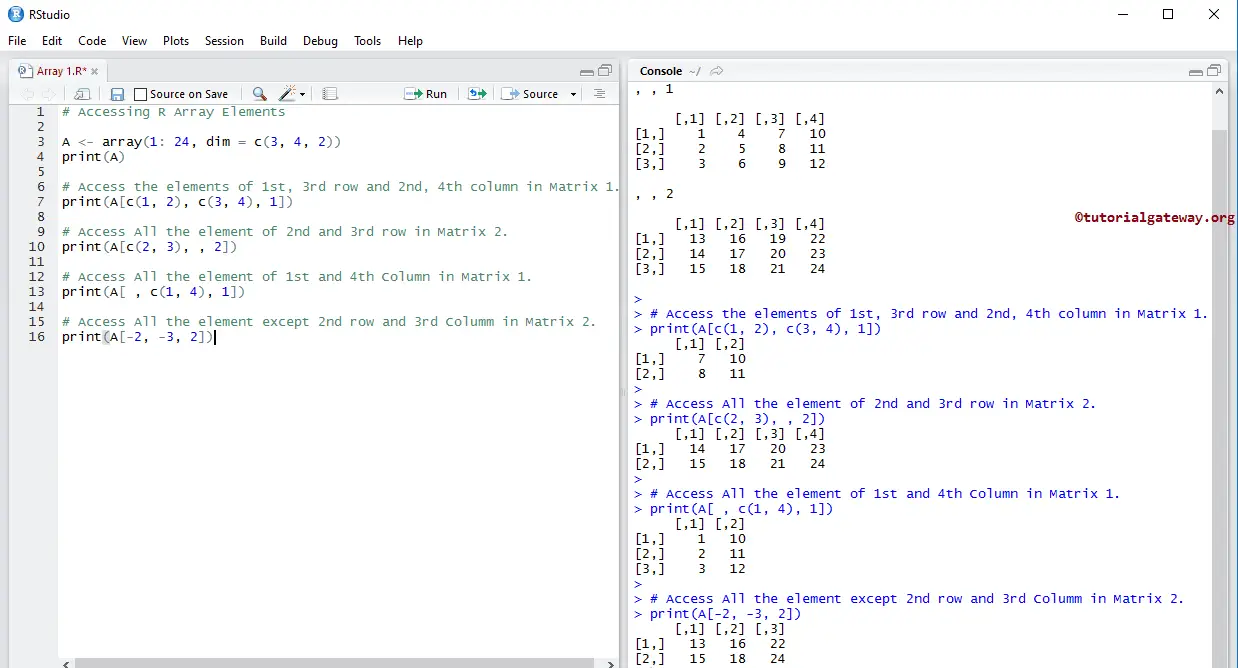
R Array Addition and Subtraction
In this example, we show how to use Arithmetic Operators on Matrices to perform arithmetic Operations on the Array.
# Adding and Subtracting Elements vect1 <- c(10, 20, 40 ) vect2 <- c(55, 67, 89, 96, 100) A <- array(c(vect1, vect2), dim = c(3, 4, 2)) print(A) mat.A <- A[, , 1] mat.B <- A[, , 2] print(mat.A + mat.B) print(mat.B - mat.A)
To perform the arithmetic operations, we are converting the multidimensional matrix into a one-dimensional matrix.
mat.A <- A[, , 1] mat.B <- A[, , 2]
